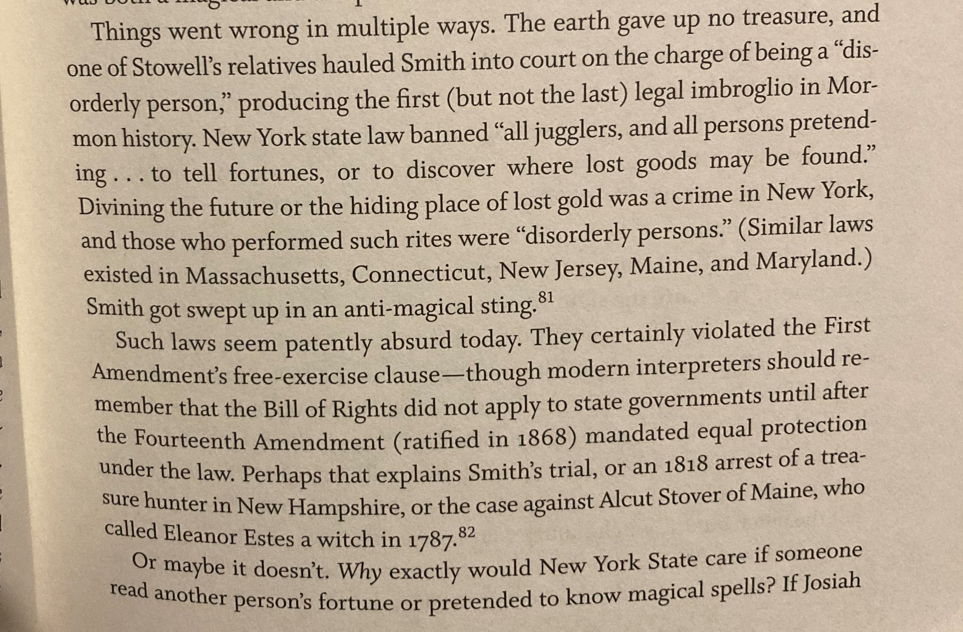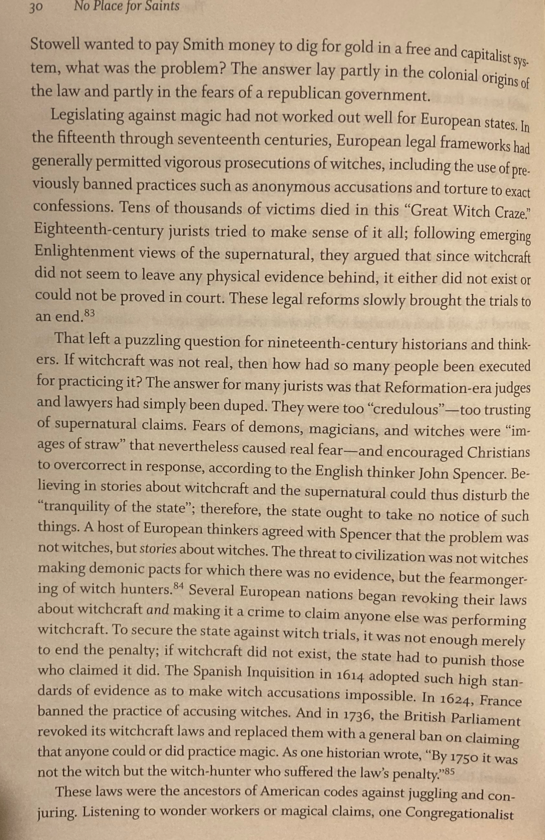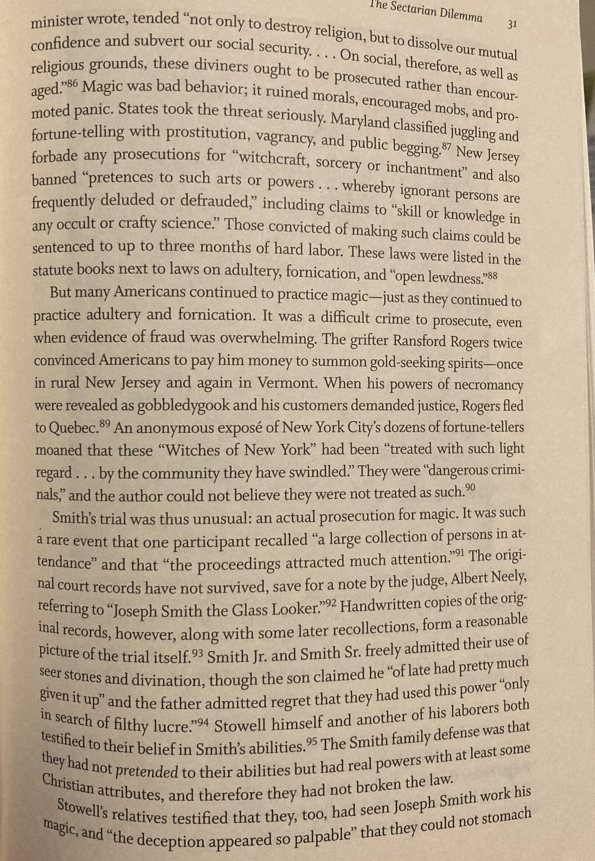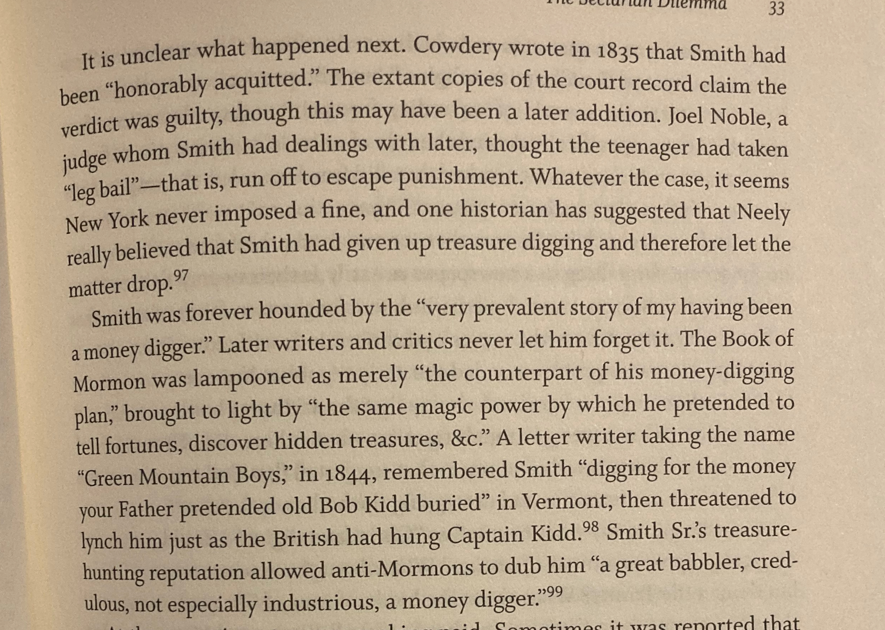Jortner provides an overview of the anti-supernatural bias of laws concerning witchcraft and how in the Post-Enlightenment era and that Smith's hearing/trial is an anomaly.
- Type
- Book
- Source
- Adam Jortner Non-LDS
- Hearsay
- DirectSecondary
- Reference
Adam Jortner, No Place for Saints: Mobs and Mormons in Jacksonian America (Witnesses to History; Baltimore, Md.: John Hopkins University Press, 2021), 29-33
- Scribe/Publisher
- John Hopkins
- People
- John Spencer, Joseph Smith, Sr., Josiah Stowell, Ransford Rogers, Joseph Smith, Jr., Oliver Cowdery, Adam Jortner, Alcut Stover, Albert Neely
- Audience
- Reading Public
- Transcription
Things went wrong in multiple ways. The earth gave up no reassure, and one of Stowell’s relatives hauled Smith into court on the charge of being a “disorderly person,” producing the first (but not the last) legal imbroglio in Mormon history. New York state law banned “all jugglers, and all persons pretending . . . to tell fortunes, or to discover where lost goods may be found.” Divining the future or the hiding place or lost gold was a crime in New York, and those who performed such rites were “disorderly persons.” (Similar laws existed in Massachusetts, Connecticut, New Jersey, Maine, and Maryland.) Smith got swept up in an anti-magical sting.
Such laws seem patently absurd today. They certainly violated the First Amendment’s free-exercise clause—though modern interpreters should remember that the Bills of Rights did not apply to state governments until after the Fourteenth Amendment (ratified in 1868) mandated equal protection under the law. Perhaps that explains Smith’s trial, or an 1818 arrest of a treasure hunter in New Hampshire, or the case of Alcut Stover of Maine, who called Eleanor Estes a witch in 1787.
Or maybe it doesn’t. Why exactly would New York State care if someone read another person’s fortune or pretended to know magical spells? If Josiah Stowell wanted to pay Smith money to dig for gold in a free and capitalist system, what was the problem? The answer lay partly in the colonial origins of the law and partly in the fears of a republican government.
Legislating against magic had not worked out well for European states. In the fifteenth through seventeenth centuries, European legal frameworks had generally permitted vigorous prosecutions of witches, including the use of previously banned practices such as anonymous accusations and torture to exact confessions. Tens of thousands of victims died in this “Great Witch Craze.” Eighteenth-century jurists tried to make sense of it all; following emerging Enlightenment views of the supernatural, they argued that since witchcraft did not seem to leave any physical evidence behind, it either did not exist or could not be proved in court. These legal reforms slowly brought the trials to an end.
That left a puzzling question for nineteenth-century historians and thinkers. If witchcraft was not real, then how had to many people been executed for practicing it? The answer for many jurists was that Reformation-era judges and lawyers had simply been duped. They were too “credulous”—too trusting of supernatural claims. Fears of demons, magicians, and witches were “images of straw” that nevertheless caused real fear—and encouraged Christians to overcorrect in response, according to the English thinker John Spencer. Believing in stories about witchcraft and the supernatural could thus disturb the “tranquillity of the state”; therefore, the state ought to take no notice of such things. A host of European thinkers agreed with Spencer that the problem was not witches, but stories about witches. The threat to civilization was not witches making demonic pacts for which there was no evidence, but the fearmongering of witch hunters. Several European nations began revoking their laws about witchcraft and making it a crime to claim anyone else was performing witchcraft. To secure the state against witch trials, it was not enough merely to end the penalty; if witchcraft did not exist, the state had to punish those who claimed it did. The Spanish Inquisition in 1614 adopted such standards of evidence as to make witch accusations impossible. In 1624, France banned the practice of accusing witches. And in 1736, the British Parliament revoked its witchcraft laws and replaced them with a general ban on claiming that anyone could or did practice magic. As one historian wrote, “By 1750 it was not the witch but the witch-hunter who suffered the law’s penalty.”
These laws were the ancestors of American codes against juggling and conjuring. Listening to wonder works or magical claims, one Congregational minister wrote, tended “not only to destroy religion, but to dissolve our mutual confidence and subvert our social security. . . . On social, therefore, as well as religious grounds, these diviners ought to be prosecuted rather than encouraged.” Magic was bad behavior; it ruined morals, encouraged mobs, and promoted panic. States took the threat seriously. Maryland classified juggling and fortune-telling with prostitution, vagrancy, and public begging. New Jersey forbade any prosecutions for “witchcraft, sorcery, or inchantment” and also banned “pretences to such arts or powers . . . whereby ignorant persons are frequently deluded or defrauded,” including claims to “skill or knowledge in any occult or crafty science.” Those convicted of making such claims could be sentenced to up to three months of hard labor. These laws were listed in the statue books next to laws on adultery, fornication, and “open lewdness.”
But many Americans continued to practice magic—just as they continued to practice adultery and fornication. It was a difficult crime to prosecute, even when evidence of fraud was overwhelming. The grifter Ransford Rogers twice convinced Americans to pay him money to summon gold-seeking spirits—once in rural New Jersey and again in Vermont. When his powers of necromancy were revealed as gobbledygook and his customers demanded justice, Rogers fled to Quebec. An anonymous exposé of New York City’s dozens of fortune-tellers moaned that these “Witches of New York” had been “treated with such light regard . . . by the community they have swindled.” They were “dangerous criminals,” and the author would not believe they were not treated as such.
Smith’s trial was thus unusual: an actual prosecution for magic. It was such a rare event that one participant recalled “a large collection of persons in attendance” and that “the proceedings attracted much attention.” The original court records have not survived, save for a note by the judge, Albert Neely, referring to “Joseph Smith the Glass Looker.” Handwritten copies of the original records, however, along with some later recollections, form a reasonable picture of the trial itself. Smith Jr. and Smith Sr. freely admitted their use of seer stones and divination, though the son claimed he “of late had pretty much given it up” and the father admitted regret that they had used this power “only in search of filthy lucre.” Stowell himself and another of his laborers both testified to their belief in Smith’s abilities. The Smith family defense was that they had not pretended to their abilities but had real powers with at least some Christian attributes, and therefore they had not broken the law.
Stowell’s relatives testified that they, too, had seen Joseph Smith work his magic, and “the deception appeared so palpable” that they could not stomach the matter. Indeed, the case itself was initiated by Stowell’s relatives, who likely though that the time had come for Stowell to stop throwing his money away. Judge Neely therefore had an epistemological as well as well as a legal question to answer: Did Joseph Smith Jr. actually possess divine magical powers—and was he therefore innocent? Or had he faked it and thereby broken the law?
It is unclear what happened next. Cowdery wrote in 1835 that Smith had been “honorably acquitted.” The extant copies of the court record claim the verdict was guilty, though this may have bene a later addition. Joel Noble, a judge whom Smith had dealings with later, though the teenager had taken “leg bail”—that is, run off to escape punishment. Whatever the case, it seems New York never imposed a fine, and one historian has suggested that Neely really believed that Smith had given up treasure digging and therefore let the matter drop.
Smith was forever hounded by the “very prevalent story of my having been a money digger.” Later writers and critics never let him forget it. The Book of Mormon was lampooned as merely “the counterpart of his money-digging plan,” brought to light by “the same magic power by which he pretended to tell fortunes, discover hidden treasures, &c.” A letter writer taking the name “Green Mountain Boys,” in 1844, remembered Smith “digging for the money your Father pretended old Bob Kidd buried” in Vermont, then threatened to lynch him just as the British had hung Captain Kidd. Smith Sr’s treasure hunting reputation allowed anti-Mormons to dub him “a great babbler, credulous, not especially industrious, a money digger.”
- Citations in Mormonr Qnas
The B. H. Roberts Foundation is not owned by, operated by, or affiliated with the Church of Jesus Christ of Latter-day Saints.





